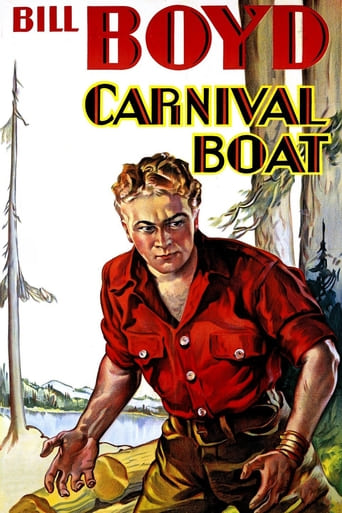vert001
Probably the best thing about CARNIVAL BOAT is the location filming as director Albert Rogell actually took the crew up to logging country for the bulk of the shooting. Otherwise it's your basic action programmer with some good stunt work and some tedious comic relief from Edgar Kennedy and Harry Sweet. William Boyd, later Hopalong Cassidy, stars as the lumberjack torn between father and sweetheart (Ginger Rogers). This may be the low point of Ginger's film career. It was her third Hollywood film (after five in New York), all made for Albert Rogell at RKO/Pathe. She seemed stuck in a downward trend (Pathe really didn't make any good films so far as I know) so she asked out of her contract and Pathe was more than happy to grant her the favor. A couple of years of freelancing and she signed again with RKO, soon to become a star.
l_rawjalaurence
Directed by 'B' Movie stalwart Albert S. Rogell, CARNIVAL BOAT has a lot of action packed into it - a daring train escape, an explosion involving lumberjacks, several fist-fights, a burlesque stage show and a love-affair involving Buck Gannon (William Boyd) and Honey (Ginger Rogers).The action zips by, interspersed with comic routines from Baldy (Edgar Kennedy) and Stubby (Harry Sweet). The plot is nothing much to speak of - suffice to say it involves a love-affair, patriarchal jealousy and a final reconciliation. But then not much else is expected of a 'B' flick designed to provide an aperitif to the main feature.Of perhaps more interest, however, is the film's representation of gender. Set among a gang of lumberjacks, it suggests that the workers like to prove their masculinity through fighting and drinking; if they don't get the chance to indulge in such worldly pleasures, they get bored. Honey is basically there as an object of Buck's affection; a largely passive character, she spends quite some time as an onlooker while Buck engineers the predictable happy ending. Such stereotypes are characteristic of early Thirties Hollywood movies; but what sets CARNIVAL TRAIN apart is its emphasis on the fragility of masculinity; it really seems as if the lumberjacks have to prove themselves time and again that they are the strong silent types - even when there is no one around to admire them. This makes for an intriguing film, where the fight-sequences serve no real plot-purpose, but exist solely for the workers' self- esteem.
Neil Doyle
If it weren't for the way the logging camp scenes are photographed, including railway chases aboard the lumber train and stunts that have to be seen to be believed, CARNIVAL BOAT would pass the time quickly as a routine story of a little romance against a splendid outdoor setting.WILLIAM BOYD plays the man who wants to become lumber boss and follow in the footsteps of his father. His romance with a showgirl (GINGER ROGERS) provides conflict for the father/son relationship when dad wants his son to ditch the girl and concentrate on becoming a foreman. Ginger's role is rather small, but she makes the most of a few touching scenes whereby she realizes she might be the wrong sweetheart for the lumberjack. FRED KOHLER makes an impressive "heavy" as the villain of the piece, a man not only willing to fight his rival but attempting to kill him.EDGAR KENNEDY (doing his slow burn schtick) and HARRY SWEET provide the comedy relief, but it's all of the action stunts that steal the show and turn it into a better than average programmer from RKO. The dangerous stunts performed aboard moving trains full of lumber are especially well photographed, as are all of the scenes involving the cutting down of timber and setting free a log-jammed waterfall.A much better film than I expected, giving WILLIAM BOYD a strong hero role that he makes the most of.
Arthur Hausner
The impressive logging operations, the exciting runaway-train and log-jam sequences overcome this movie's routine double plot. First, Bill Boyd is in love with showgirl Ginger Rogers, who performs on a carnival boat that stops at the logging camp. His father, Hobart Bosworth, doesn't think much of her and he fears also Boyd will leave logging, dashing his hopes for Boyd to become boss when he retires. Second, Fred Kohler is also vying for the job of boss and even resorts to tactics to make Boyd look bad. When this fails, he even considers murder when both try to break up a log jam at a dam with dynamite. The film is briskly paced and beautifully photographed. Edgar Kennedy and his logging partner, Harry Sweet, provide the little comedy relief there is, and there is a couple of realistic looking fight sequences.


